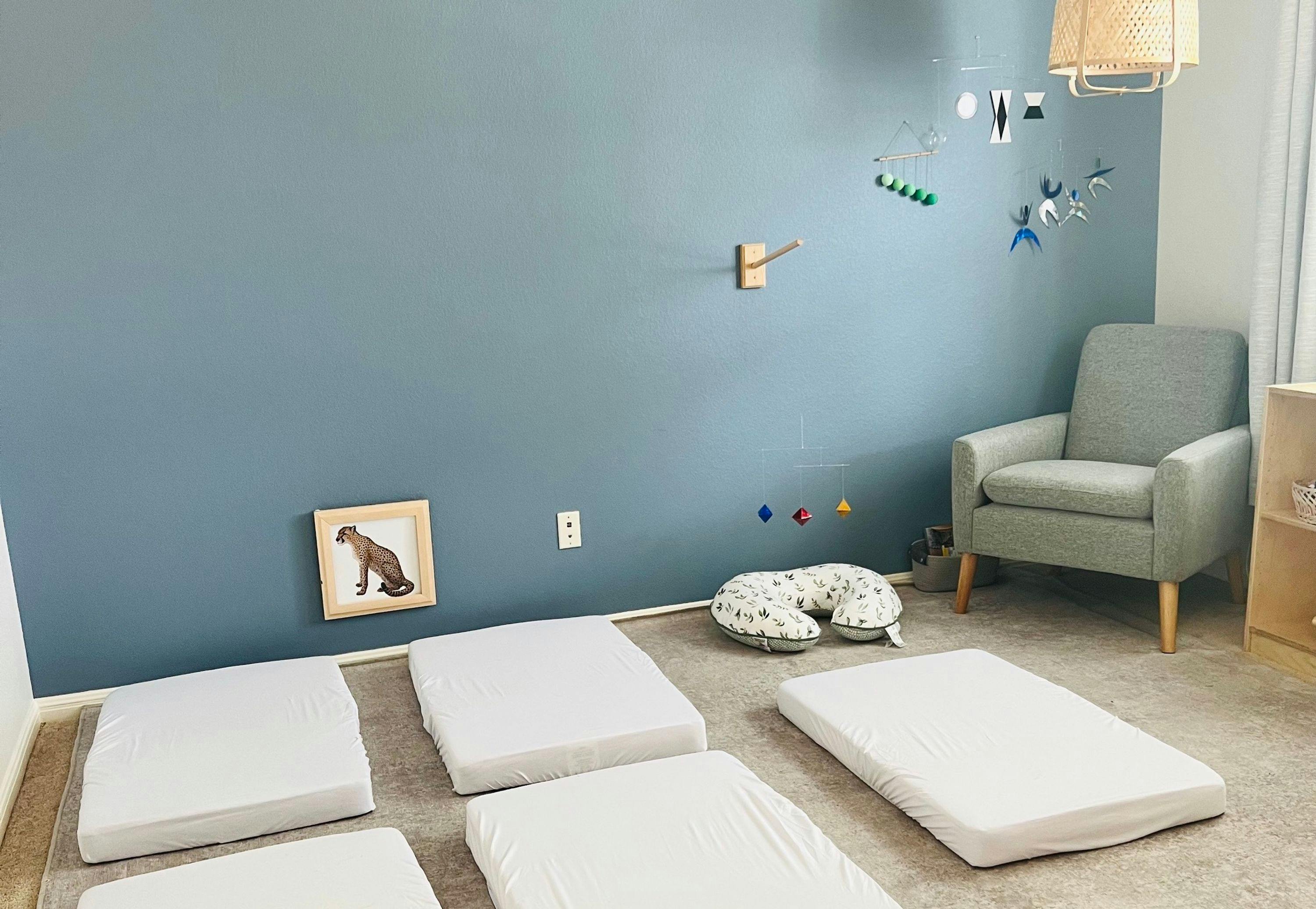A Look Inside Our In-home Picco Classrooms
Like all our Montessori Nido classrooms, our in-home Picco classrooms are meticulously designed to offer children a safe, nurturing and stimulating space that encourages independence.
One of the key pillars of a Montessori education is the ‘prepared environment’—a carefully designed classroom or learning space that is specifically tailored to the needs of the child. In Montessori classrooms, every aspect of the space, from the furniture and materials to the layout and daily routines, is intentionally chosen to support the child's learning experience.
Just as in our brick-and-mortar Guidepost locations, our in-home Picco classrooms are thoughtfully designed to foster independence, exploration and a love of learning for each child. Laura St. John, Guidepost’s Prepared Environment Specialist, played a lead role in designing the classrooms at our first Picco location—Guidepost at Round Rock-Fincastle.
Every aspect of the room is designed with the children's development in mind: from the floor mattresses that allow freedom of movement, to the eye-level art, and hanging mobiles that help to develop concentration.
“As we were preparing the Picco classrooms, we started by thinking about the child’s daily routine,” Laura explained. “Infants spend much of the day sleeping, eating and enjoying their surroundings during their awake times. So, we made sure that everything in the home was intentionally placed for each period of the day.” Round Rock-Fincastle features a designated quiet area for napping, a fully-equipped kitchen with small tables and chairs where meals are served, and a separate room for sensory and practical life activities.
Children who can comfortably sit up on their own are encouraged to sit at a child-size table and chair to eat their meals and snacks. While sitting, they learn to use utensils, develop their fine motor skills, and engage with their friends during mealtime.
In every designated area of a Montessori infant classroom, the goal is to design a space for the abilities and needs of children so they can joyfully achieve independence and reach their highest potential. In the designated napping area, for example, children are able to crawl in and out of their floor mattress independently rather than waiting to be placed into or carried out of a crib. In the dining area, too, as soon as a child is able to comfortably sit up by themselves, they can sit at a table and chair appropriately sized for them and low to the ground so they can safely and easily crawl in and out on their own, rather than being placed in a highchair to eat.
In designing the Picco classrooms, Laura placed a heavy emphasis on order and structure; everything in the classroom has a defined place and purpose. “We know that children are very attuned to what is in their space,” Laura shared. “So we aim to be especially thoughtful about what goes where.” This not only helps children feel secure and develop a sense of autonomy and responsibility, but over time, it also enables them to take ownership of their learning experience. Courtney Cobb, the lead guide at Picco at Round Rock-Fincastle, received training through the Prepared Montessorian Institute on how to present all of the materials and worked closely with Laura to set up the environment.
This sensory shelf includes a selection of puzzles, stacking cups, shapes on a knobbed peg, and an object permanence box with drawer. All of these materials are designed to help the children develop their fine motor skills.
Throughout the Picco classrooms you’ll find beautiful, natural furniture and materials. There are wooden tables and shelves, as well as art at the child’s level. There are carefully curated collections of learning materials, including rattles, interlocking rings and grasping cloths. The language shelf is adorned with baskets of familiar child-safe household objects for the children to engage with, while a practical life shelf has all of the materials needed to help the children set the table, water plants, and keep their space clean and tidy. Another psychosensory area includes music boxes, puzzles, stacking cups, and a ball tracker. There’s also a baby gym and mobiles set up for the littlest ones in the classroom. A spacious play area that has pull up bars, pebble cushions and a Nugget play couch supports the development of gross motor skills. “The materials that we select are not only aesthetically pleasing and engaging,” Laura explained. “They’ve been carefully selected to help the children meet specific developmental goals.”
The baby gym area is a perfect spot for infants to practice reaching, grasping and kicking. It also provides a fun and engaging space for the youngest members of the class to develop their concentration. In the background, you'll see a nose-blowing station as well as a Montessori Ball Tracker, which helps the children develop hand-eye coordination, concentration and fine motor skills.
Even for children as young as 12 weeks old, the Montessori prepared environment is characterized by a focus on concentration, independence, and self-direction. Children in our Picco classrooms are given the freedom to choose their own learning activities from a variety of options, and the space to concentrate and persist in their goals for as long as they want. Once the environment has been prepared, our guides take on an observant and supportive role, watching carefully to understand the child’s needs and track their progress, while providing guidance and feedback as needed so the child can confidently move from one accomplishment to the next.
The Picco prepared environment is designed to support the children in every aspect of their development, from cognitive and fine motor skills development to social and emotional growth. We believe that by providing a beautiful, well-organized, and purposeful space in which children can learn and grow, we are fostering independence and self-confidence, and promoting a love of learning that will last a lifetime.
If you'd like to learn more about our in-home Picco program for infants and toddlers, please visit the Guidepost Montessori Picco webpage.
